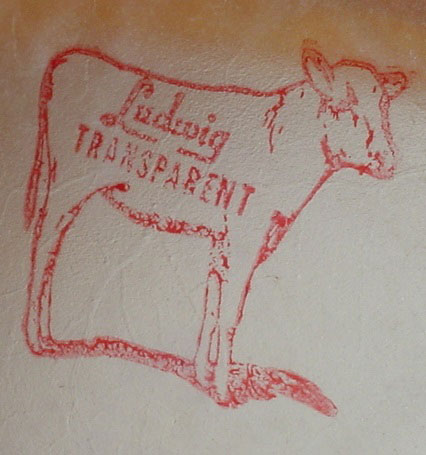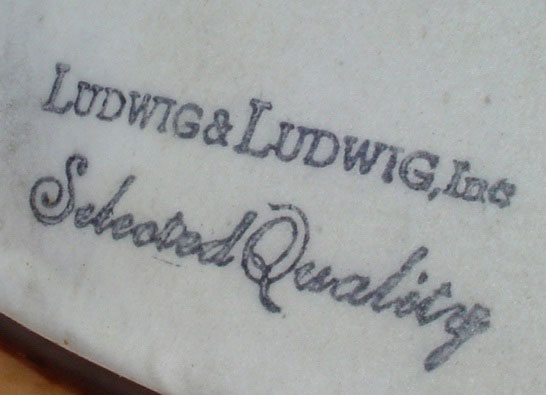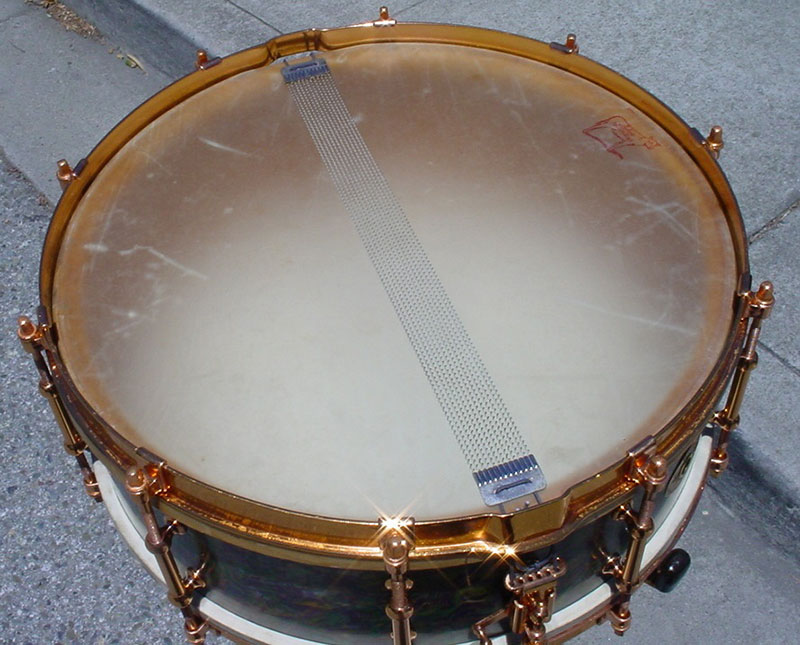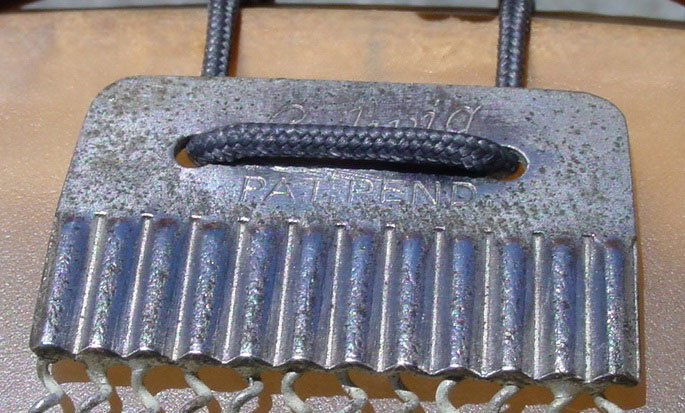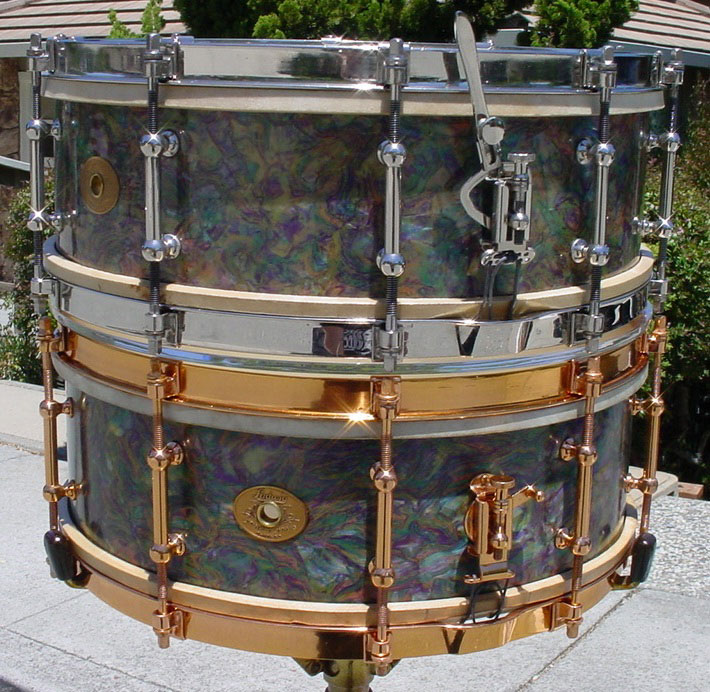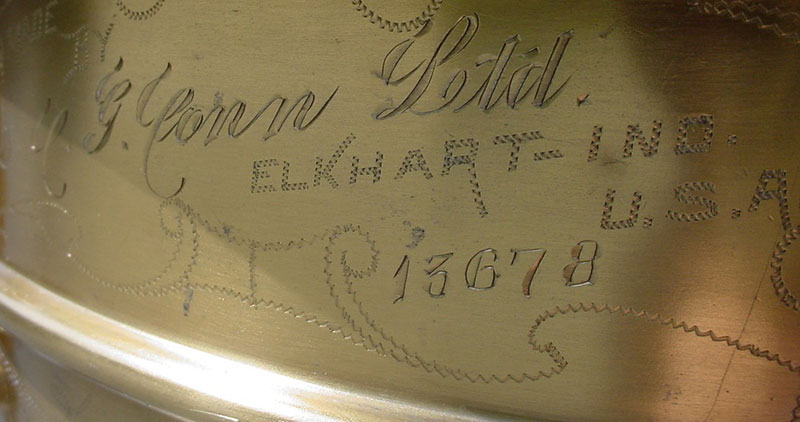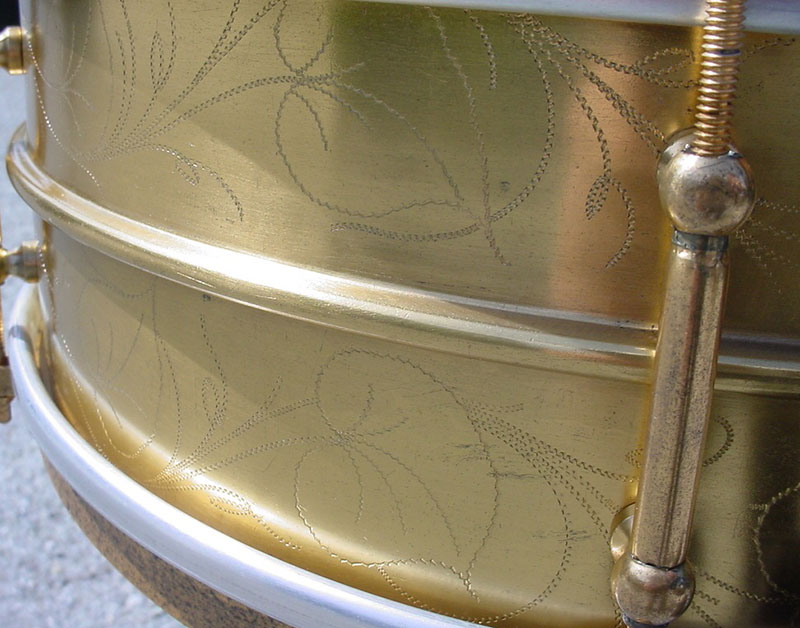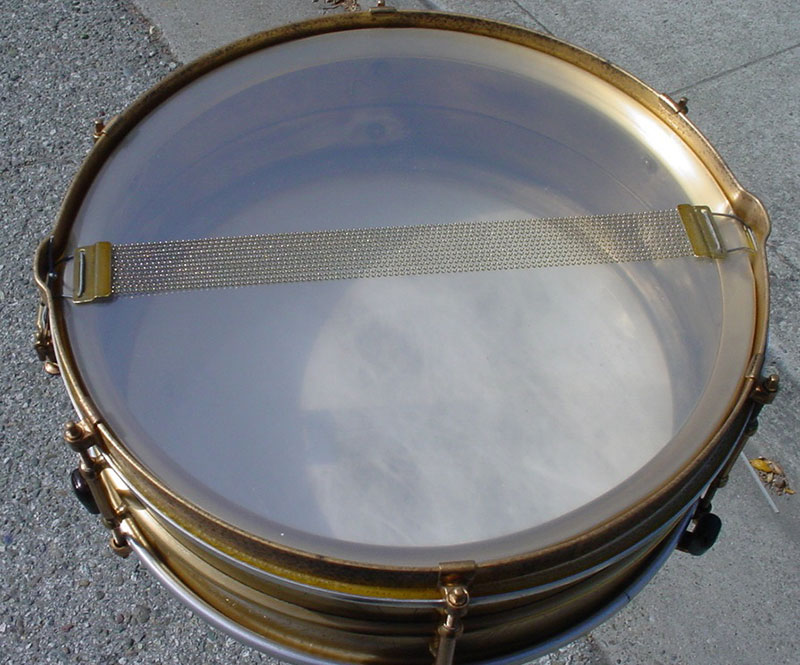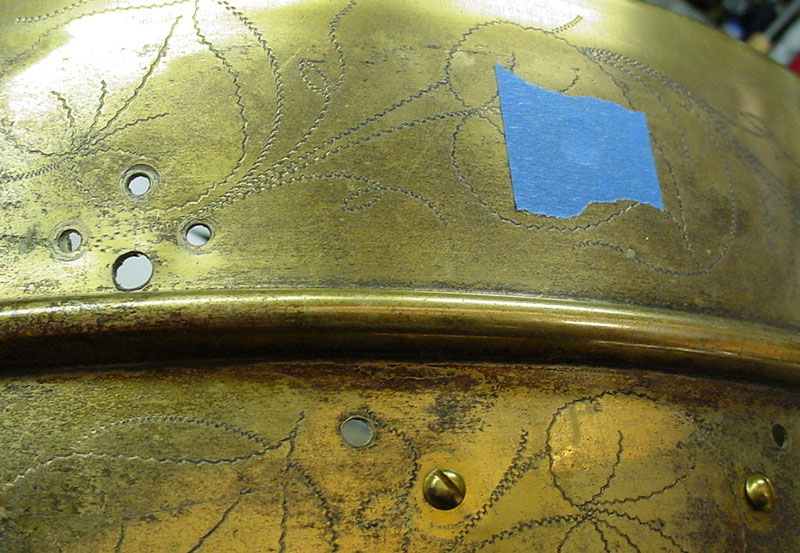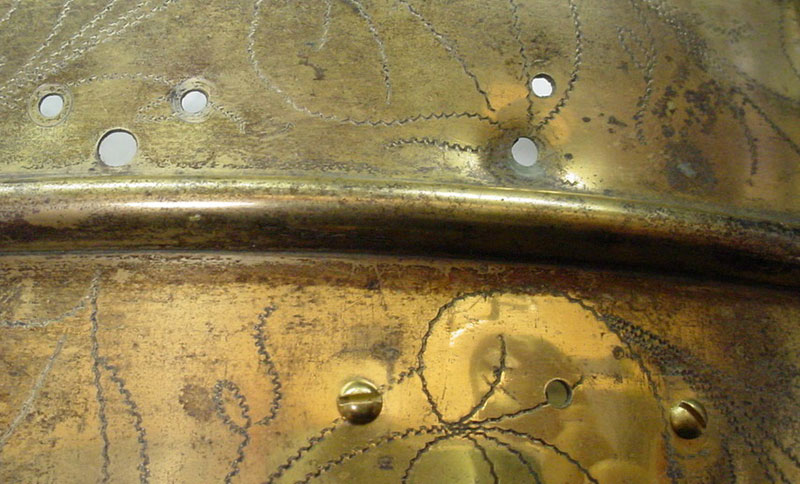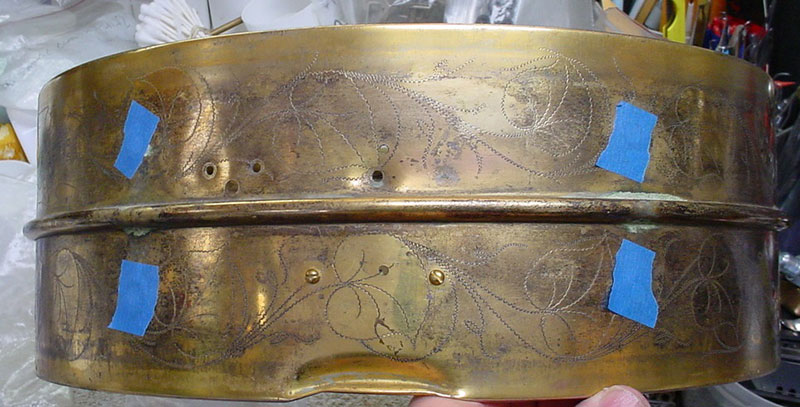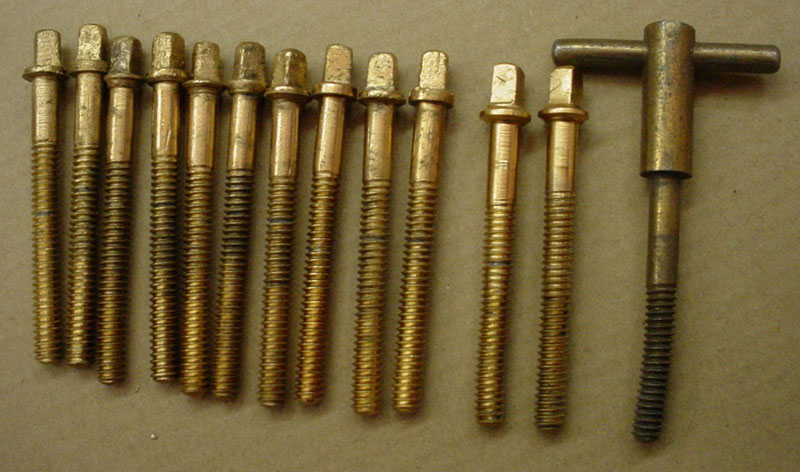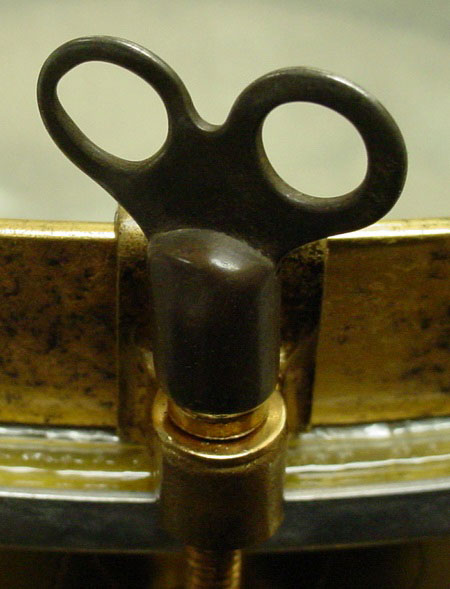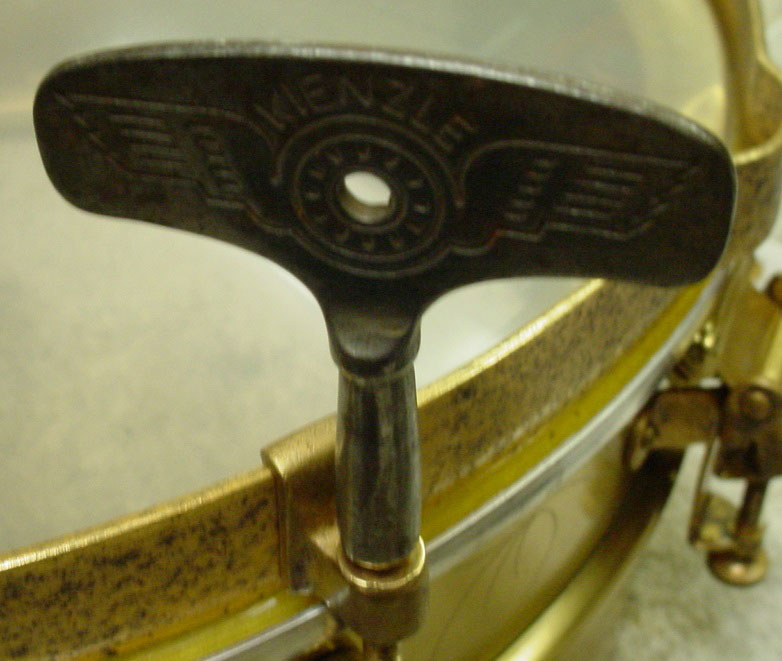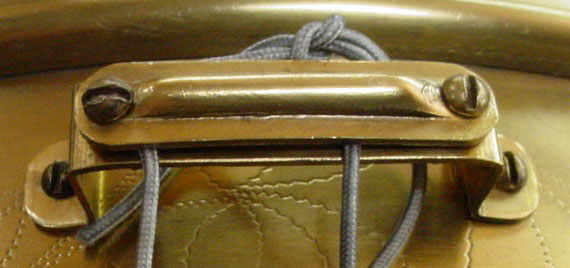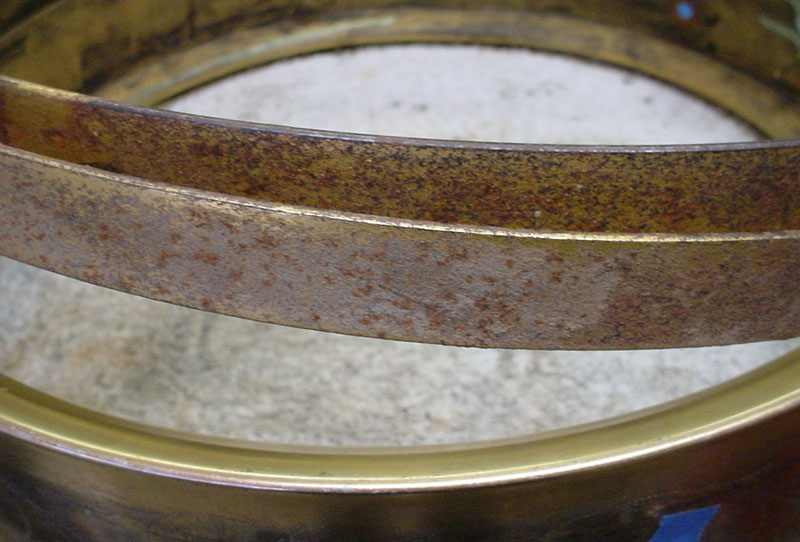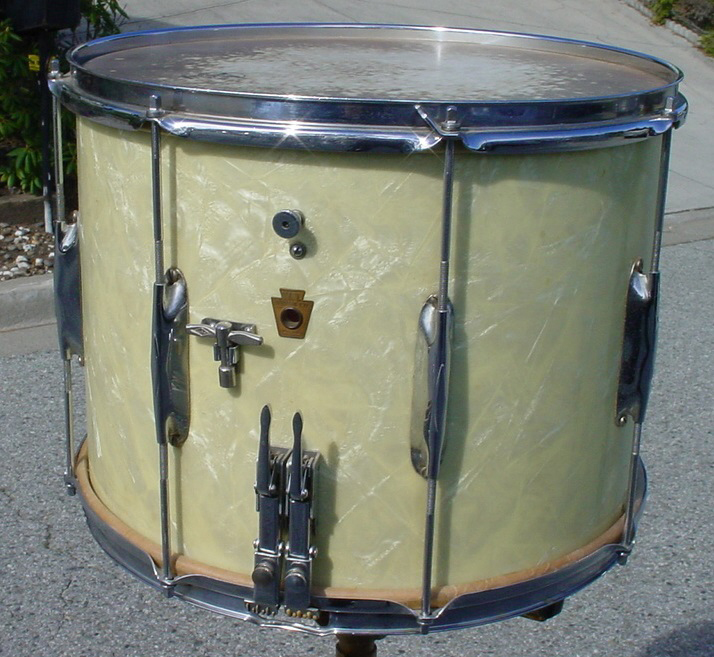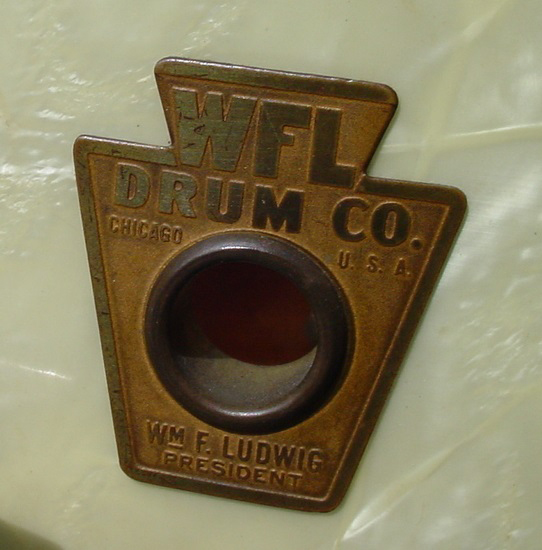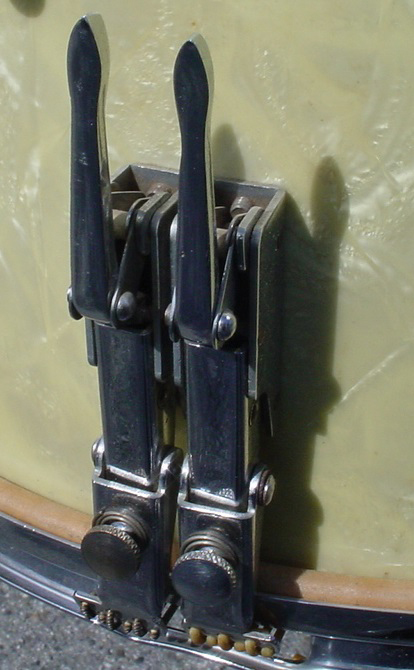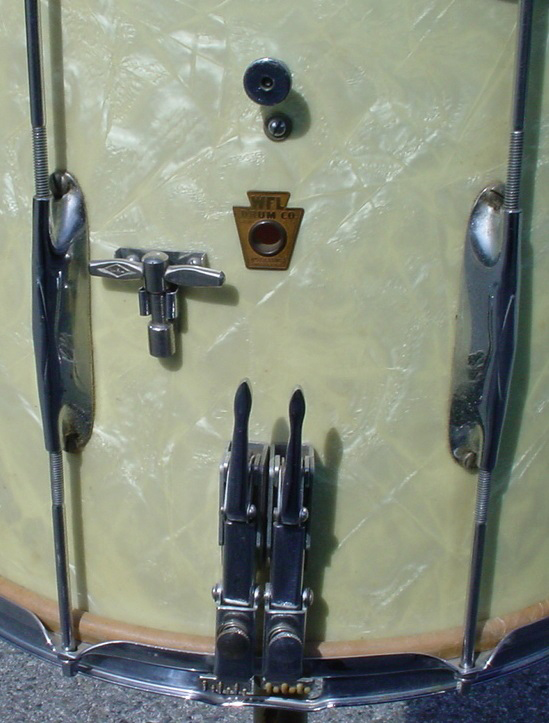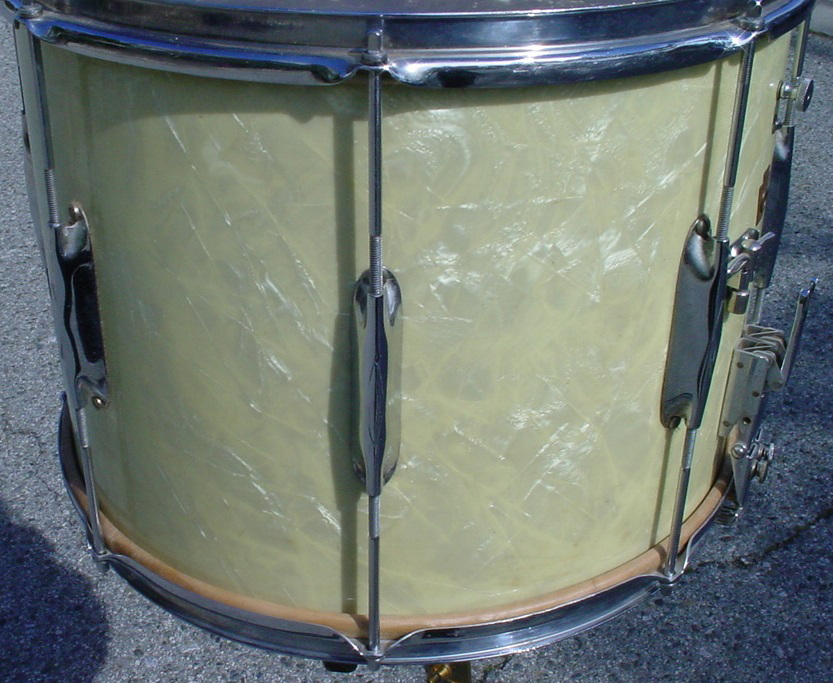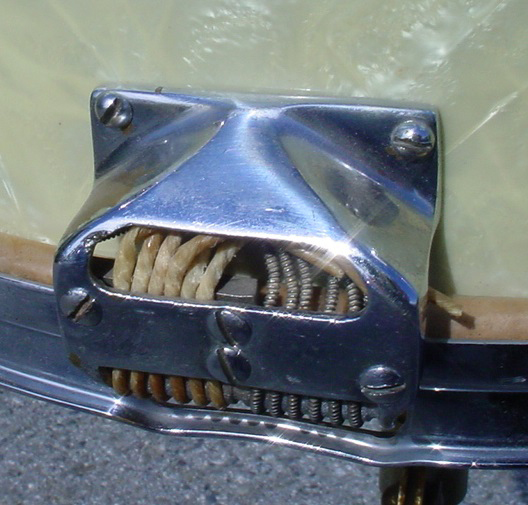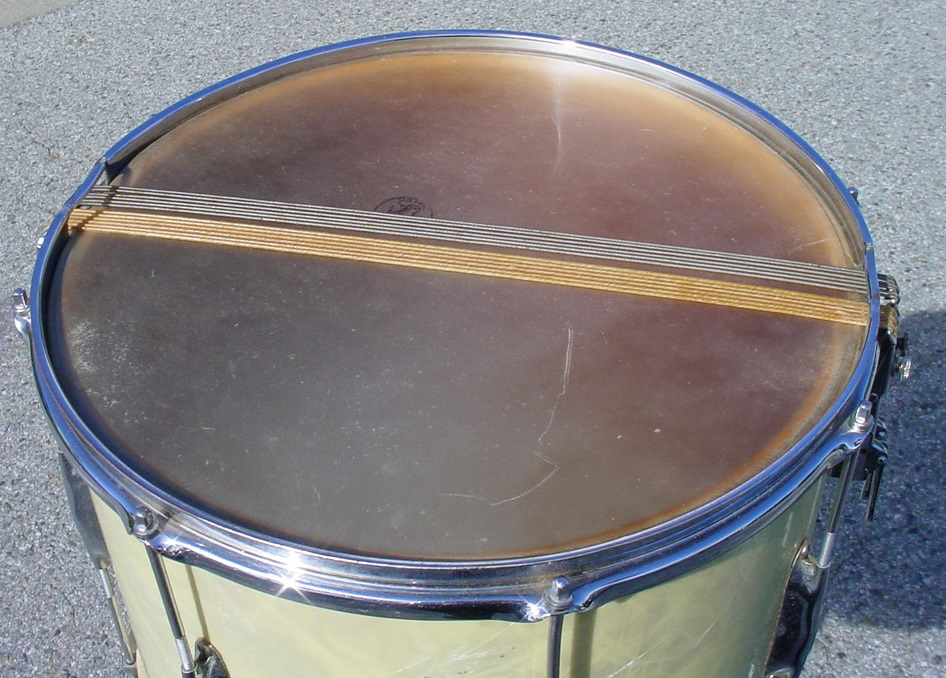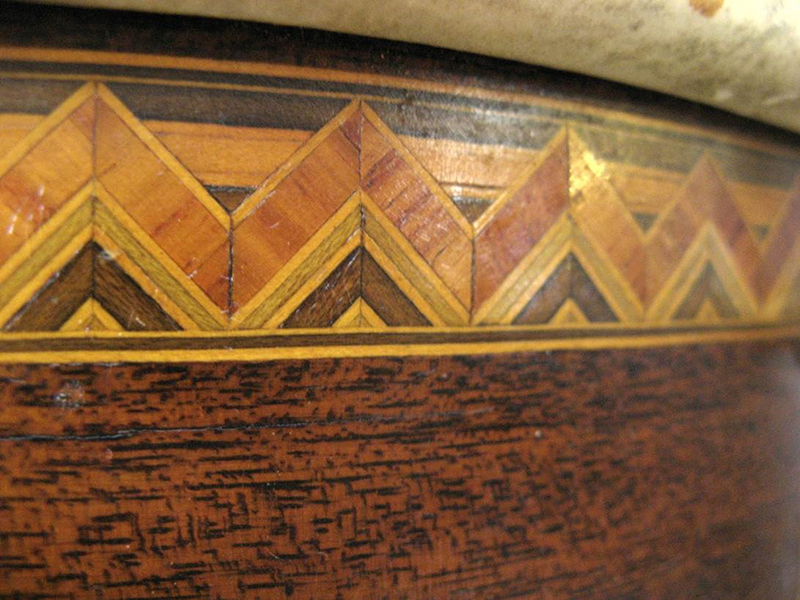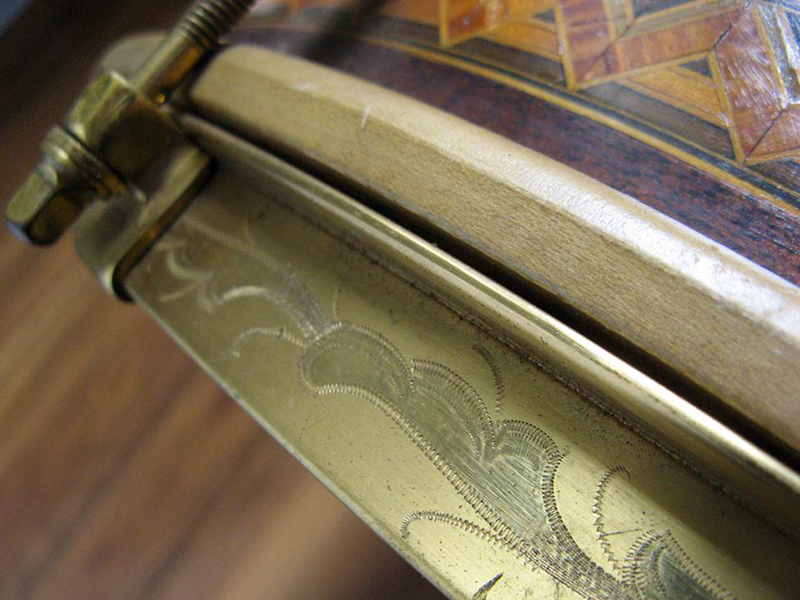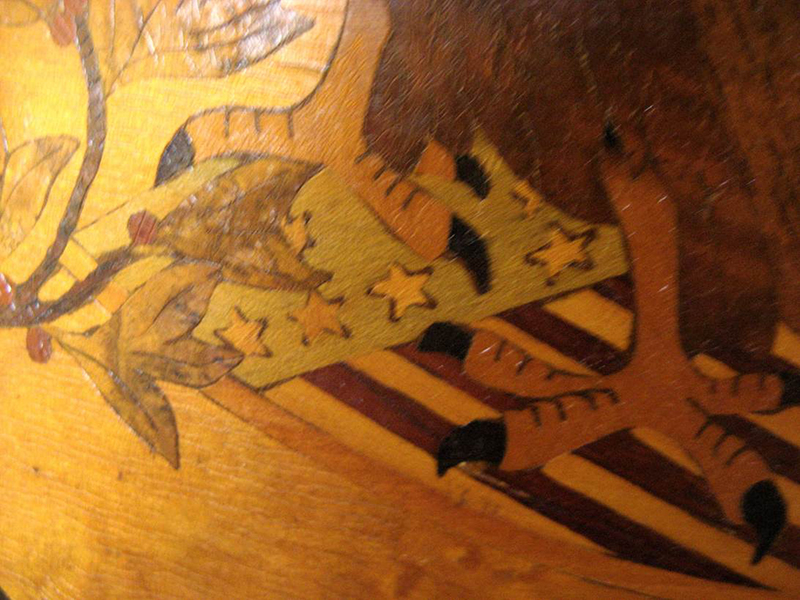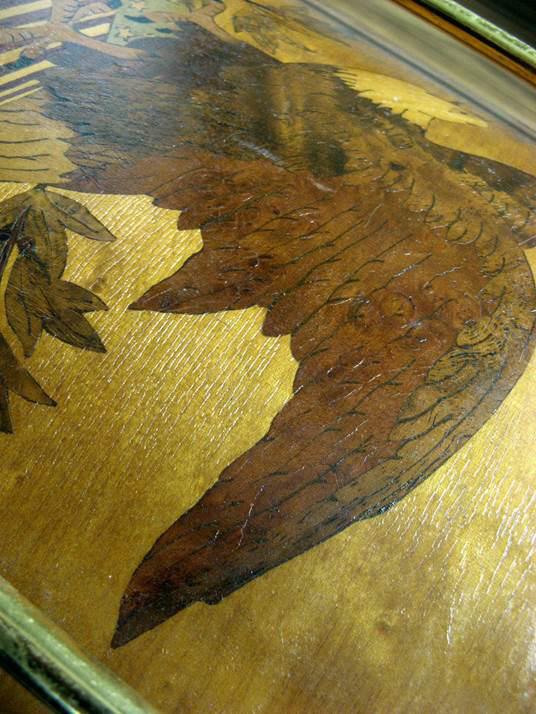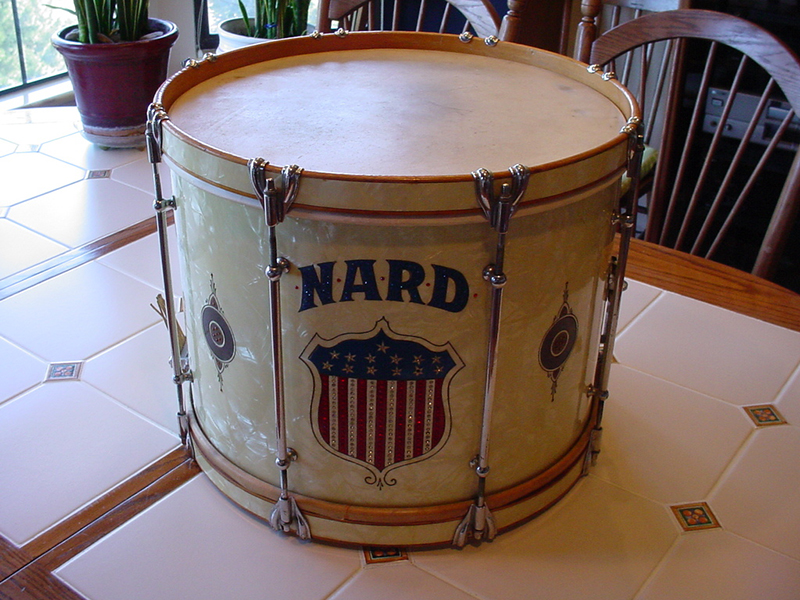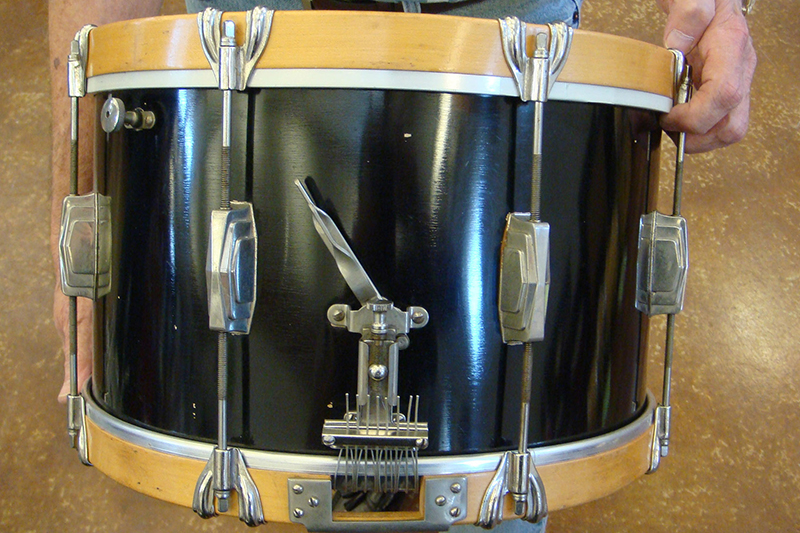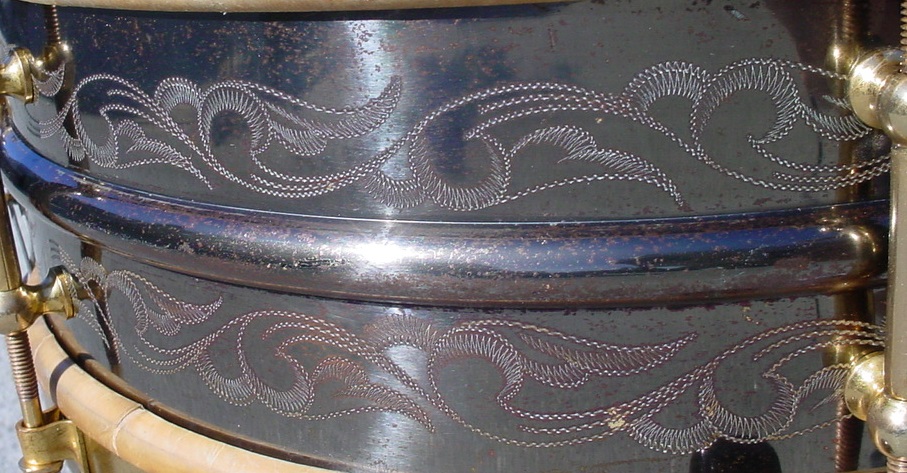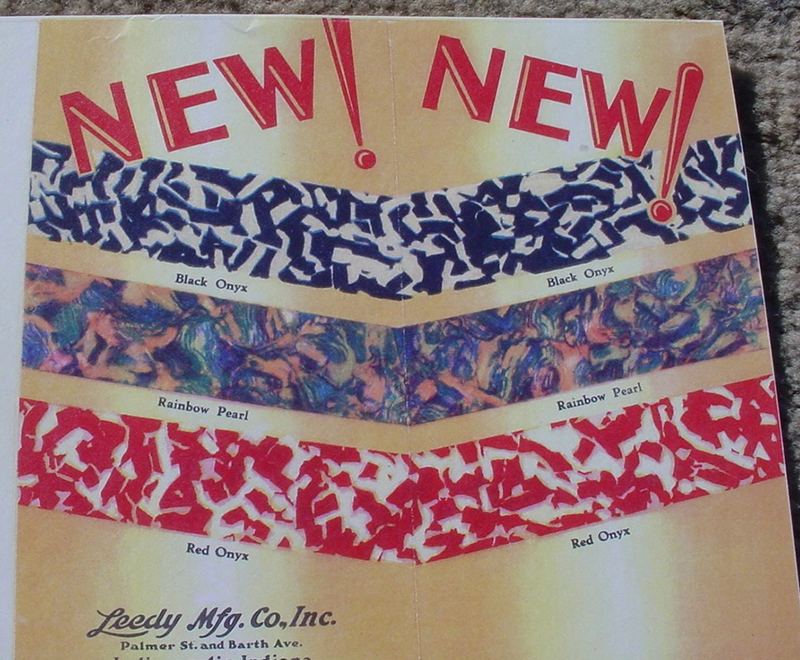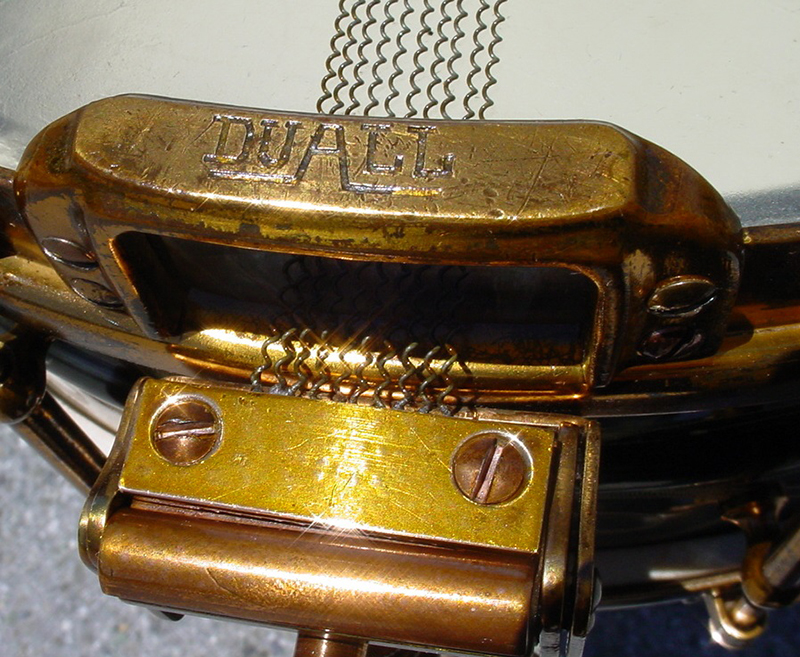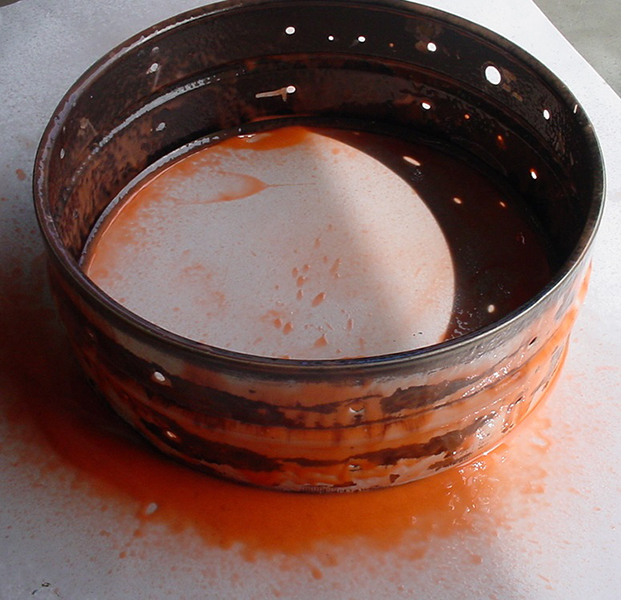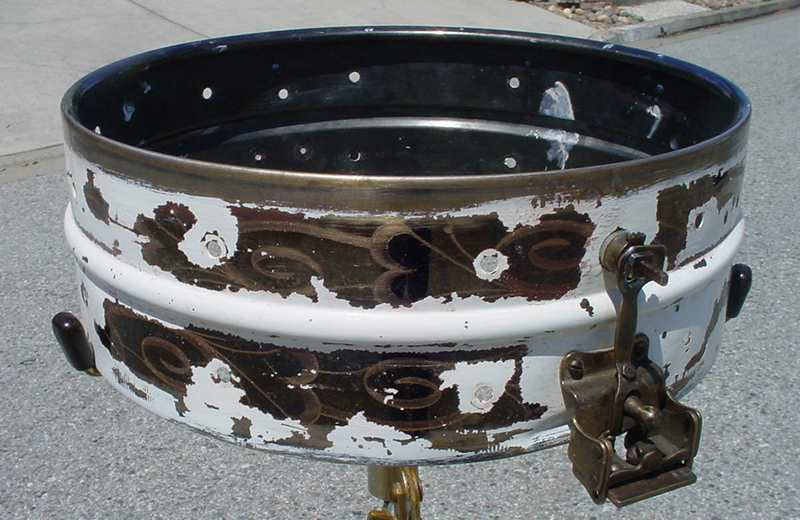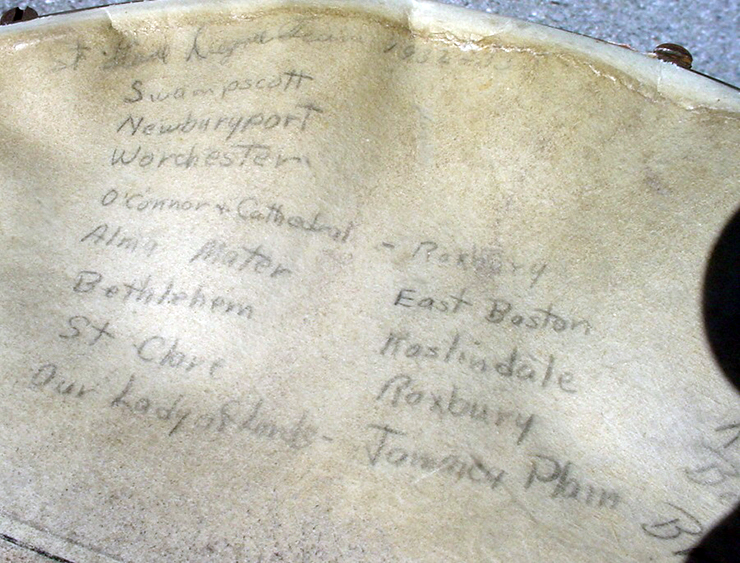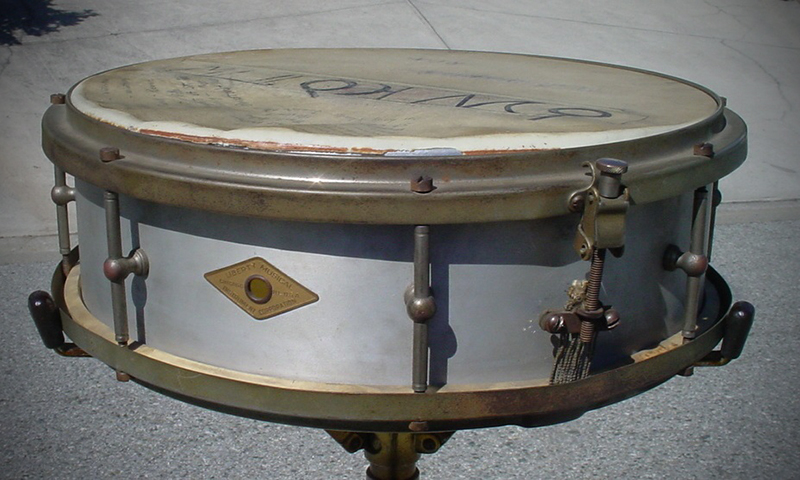This was an easy one but I do have a restoration tip to pass along. This is purely personal but maybe a few restorers out there will find this useful. If you notice on all of my restorations you will see “aged” snare cord. I think that it looks out of place to have brand new white snare cord on an 85 year old drum; functionally it’s no problem, visually it drives me nuts. Here are two tips for you... 1. I use Yamaha snare cord model SNC-10 but before installing the snares I run the cords through a used (blackened) piece of Cape Cod Polishing Cloth, this darkens (antiques) the white cord and in my opinion makes it more realistic looking... 2. I just discovered Puresound makes model MS4 (dark brown brained line). This is what I used on the drum in this article.
Read more1928-30 L&L "Rainbow" Pearl
Hi all,
I just got this 1928-30 5 x 14 Ludwig & Ludwig “Rainbow Pearl”/DeLuxe Standard Model snare drum from my good friend and fellow collector Donn Bennett of Donn Bennett Drum Studios in Belleview, WA. The drum needed no cleaning or restoring. The solid maple shell interior is clean with a tight grommet/badge and the “finish” is very clean. There is no tone control, tone controls show up in the L & L catalog around 1932 hence the 1928-30 dating. The DeLuxe hardware was restored by Adrian Kirchler of AK Drums in Italy. The only thing I added was of-the-era top and bottom Ludwig & Ludwig calf heads and Ludwig & Ludwig Snappi-type wires.
The real story is in the identification of the finish that is on this drum. I’ll try to explain as best as I can but there are definite inconsistencies that I will site along the way. The finish on this drum (and on the only other drum like this that I have ever seen) has been referred to as “Rainbow Pearl”. I have included a comparison photo of both drums. Ludwig & Ludwig never had a cataloged finish called Rainbow Pearl but they did have the Rainbow Outfit but the drums were finished in Lavender Pearl (1928-35). Leedy introduced Rainbow Pearl in 1930 and it has been suggested that the finish on this drum was taken from the “Leedy side” of the building as Leedy and Ludwig & Ludwig were literally built across the way from each other as they were both owned by the C. G. Conn Co. at that time but the Leedy Rainbow Pearl snare that I own does not look at all like the “Rainbow Pearl” drum in this article. I have also included a comparison photo of the Leedy drum and this drum so the reader can see what I am talking about.
Another theory is that this could be a variation of a “run” of 1928-30 Peacock Pearl. More photos are available on page 153 of The Ludwig Book by Rob Cook, this is a nice presentation of Peacock Pearl I and Peacock Pearl II. Please note that at the top of page 153 Rob lists Peacock Pearl version I (1928-30) and Peacock version II (1930-32) but reverses the the order in the photos; the top photos should be labeled Peacock Pearl II and the bottom photos should be labeled Peacock Pearl I and be aware that the drum in the lower left is the “other” Rainbow Pearl drum that I mentioned earlier. Having fun yet, are you still with me? So what are we going to call this finish...Rainbow Pearl, Peacock Pearl I, a variation of Peacock Pearl I, a one-off run of an un-cataloged finish, a one-off special order, frog in a blender, Walt Disney threw up?
No matter what we call it I have come to really enjoy collecting this finish even though, as my good friend John Aldridge says, “that finish is as ugly as home made soap!” As always I welcome your comments, observations, information AND photos if you own a drum like this or if you have seen or heard of another drum like this one.
Enjoy! Mike Curotto
1920s C.G. Conn "Holey"
Hi all,
This one took some serious rescuing. My friend and fellow collector Robert Campbell bought this drum a while back and contacted me for my opinion on what to. My advice (if he wasn’t into the drum for too much money) was to repair, restore and preserve the drum as best as possible. Bob agreed, the following is what took place.
1920s C. G. CONN 5 x 14 SILVER PLATED/GOLD PLATED/ENGRAVED 6 LUG ALL METAL SEPARATE TENSION DRUM
The Shell: The good news is that the shell is silver plated, gold plated and nicely engraved. The bad news is that there were 15 extra holes! Yep, 15 collector-cringing extra holes.
Can you “splain it to me Lucy” why anyone in their right mind would drill 15 extra holes in this special order, gold plated and engraved shell? Extra ventilation, oh of course, how silly of me. The first stop was to get the shell into the golden hands of my welder/machinist Abe Abello of Weld-Tec in Redwood City CA. There were so many holes in this shell that I had to tape off the 17 original holes that were not to be plugged. Abe was able to plug the holes but I explained to Bob that due to the excessive heat needed to do the plugging correctly the silver and gold plating was burnt away in the areas near the extra holes. Enter Les Hagnagy of Avenue Plating in Redwood City CA...less than 50 yards away from Abe. Les tried his best to use a technique whereby he “rolls on” the gold plating just to the affected areas via a “wand” that is hooked up to the gold plating tank. Unfortunately the shell was too far gone from the extensive hole plugging that had to be done so the decision was made to simply re-gold plate the shell. After a nice clear coat the shell was brought back to life. One last interesting oddity was that the bead on the shell looked normal from the outside but on the inside you can see that there was no channel but rather a very small opening, definitely different from the Ludwig & Ludwig/Leedy shells of the same era.
The Hardware: The good news is that the hardware is gold plated. The bad news is that although you could see the gold plating on the steel rims, tension rods, collar hooks, Utility strainer and butt plate... everything was heavily rusted. The 6 brass tube lugs were fine but the gold plating had long since worn away. Les dipped all of the hardware into his cleaning tank and removed the rust but we decided to flash gold plate the hardware as there was too much rust damage. Les clear lacquered the hardware to preserve the gold plating and to at least stave off any future rust. There were two missing tension rods. These were not your normal sized tension rods but instead they were 10-24 threads with very small square heads. I had two copper plated 10-24 T-handle tension rods in my parts stash, that’s a little bit of luck on my part but the real miracle is that Abe was able fabricate two matching tension rods from what I had. I was so amazed that I had to add a photo. The Knobby Gold Leedy T-handle on the right is an example of the two that Abe had to work with, the two tension rods to the left of the T-handle are the fabricated tension rods from Abe.
Tensioning was a bit of a chore as these 10-24 C. G. Conn tension rods had very small heads so I went to my vintage key collection and found a few banjo/clock keys that worked perfectly; one key is for you Bob just in case you ever want to change heads. The Utility strainer and butt plate were quite different as compared to what we would normally see on Leedy drums from the same era (see photos). The steel band rims were in the worst condition. Les was able to remove all of the rust but the “etching” from the rust remained even after the gold plating.
I was glad that Bob wasn’t into the drum for that much money as I would have hated to see this piece of C. G. Conn history just die by the wayside. The real heroes are Abe and Les. I am very fortunate to have them associated with my hobby. Their work continues to amaze me!
Enjoy.
Mike Curotto (Drum Whisperer)
1938 WFL Concert Twin Strainer
The quest for rare, one-off, special order Street/Parade drums continues.
This latest small condominium comes from Bill Wanser and Olympic Drums & Percussion, Portland Oregon. Thanks goes to Bill who allowed me to print the story that was in the item description.
“Notes: This is a beautiful and rare WFL Twin Strainer concert field drum in original White Marine Pearl wrap. These drums were designed with two independently controlled sets of snares as described in the 1941 catalog. This design allows the player to switch between the two types of snares in an instant. All parts are original, including the drum key, and in excellent condition. The white marine pearl wrap is also in excellent condition with the only blemish being a small cigarette burn next to one of the lugs. This was caused no doubt by a relaxing drummer called to action on short notice and placing his still burning cigarette behind the tension rod. The snares are original gut and wire wound silk. The calf heads are newly tucked heads on the original flesh hoops. All chrome plated hardware is in excellent condition. This drum was used by the original owner in the Arizona State University marching band in the 1930’s. It then lived in a closet until the mid 1990’s when it was found and used in the Phoenix Symphony. An excellent sounding concert field drum that will also make an attractive addition to any collection.”
1938 WFL #482 12 x 16 DELUXE MODEL CONCERT PARADE DRUM
The Shell: The 3-ply shell is in great shape. The WMP still has a lot of white and the only blemish is the cigarette burn mentioned in the above description. The interior is clean. An easy cloth wipe down was all that was needed.
The Hardware: All of the chrome hardware is original and in great shape even the 8 notoriously unstable Zephyr lugs. The twin strainers work well and feel smooth. There was no work that was needed to be done on this drum.
I’m sure that this drum was concertized many times by Bill Wanser (Principle Percussionist, Phoenix Symphony, ret.)...now it’s “museumized.”
Enjoy!
1939-41 Gretsch Gladstone
Hi all,
Here’s another one to enter the “Mark Cooper Wing” of the Curotto Collection. I don’t have many Gretsch snare drums as most of the Gretsch collectables are 1950s-60s era which is a little late on the chain for me. My good friend Mark Cooper offered this drum to me so I decided to pull the trigger and purchase my first Gretsch Gladstone snare drum. Noted Gladstone expert and friend Chet Falzerano was kind enough to allow me to print his remarks:
“Those numbers are stamped into Gretsch shells with what appears to have been a branding iron. The Fatool drum has #255. I told Mark I think the snare pictured with the Gretsch Gladstone set in the Gretsch book has a higher number (sold that many years ago). The Chick drum I just put together is 128. I was thinking they may be production numbers as the Chick drum (with the lowest number I have seen) has some unusual features I have never seen before, namely the throw off lever is engraved, the key is stamped, and there is an adjustable stop inside the drum to regulate pressure of the pads against the head. I thought these features were dropped by Gretsch as a cost saving measure as the GG was THE most expensive drum on the market at the time. William F. Ludwig, Jr. recalls: 'I remember Gretsch reserving a suite at the Sherman Hotel (in Chicago)...and inviting all the Chicago drummers to see the marvelous Gladstone drum. The drum sold for $100, which was ridiculous in those days. Our top of the line drum was $35.' The 3-Way on eBay now (with the rewrap) is number 112 according to the owner. Back to the drawing board on the numbers.”
1939-41 (#279) 14 x 6.5 WMP GRETSCH GLADSTONE 3-WAY TUNING ORCHESTRA DRUM
The Shell: The 3-ply shell is in great shape and looks to be in round although the calf heads did take some Cooper-izing. The interior is clean with a huge “279” on the top re-ring that looks like it was applied by stamping the numbers into the re-ring rather than a branding iron type device (as Chet stated above). The photo gives the illusion that the 279 is “raised” but it is not. I am told that #279 is one of the highest numbered drums that has surfaced to date. The WMP is also in great shape, has a lot of white left and looks “classically aged” as I like to call it. The Gretsch Gladstone badge and the tone control adjustment badge are both very clean.
The Hardware: The Gretsch chrome plated rims were surprisingly in very good shape. The Gretsch Gladstone logo on the top rim looks like it is engraved. The tensions rods were a bit dirty but cleaned up nicely as did the strainer, butt plate and 3-way key. The single post lugs were in the best shape.
Special thanks goes to Mark Cooper for doing a great job of cleaning up this drum for me. I supplied of-the-era calf heads and the correct Duplex chrome 12-strand wires but I do have to say that after tightening the heads and tweaking the wires this drum is absolutely horrible sounding. This is not a big deal as I don’t play vintage drums, I just collect them.
Enjoy!
1920s L&L 12x17 Custom Street Drum
Hi all,
A small condominium has just entered into the Curotto Collection. I usually don’t collect marching snare drums but this 17 x 12 honker of a drum had all of the cool stuff that I love as a collector of vintage snare drums. Thanks goes to my good friend and fellow collector Mark Cooper of Coopers Vintage Drums for giving me the opportunity to purchase this drum and for allowing me to use his photos.
1920s LUDWIG & LUDWIG No. 223 12 x 17 GOLD PLATED/CUSTOM MARQUETRY ONE-OFF SEPARATE TENSION STREET DRUM
The Shell:
This is not faux decals as we all have seen on 1920s-30s Ludwig & Ludwig Standards, Supers, Super-Sensitives and New Era-Sensitives. The solid mahogany shell on this drum has a copious amount of expert marquetry, inlay as I used to call it. All of the marquetry is intact and in great shape. The worker who did this marquetry was a true Artisan. I can’t imagine how much this would cost nowadays. The shell just needed a little lemon oil to sharpen up things.
The Hardware:
All of the hardware is gold plated and is in great shape. The top and bottom single flanged rims are fancy engraved just like the L & L gold plated Triumphal Models of the same era. The 8 tube lugs are the longest that I have ever seen, the collar hooks and tension rods are all standard L & L issue. This drum has the optional P-338 Professional Model Throw-off and regular butt plate as compared to the “arm-less” post-type strainer and larger butt plate that are usually equipped on a drum like this. The mid-1920s L & L catalogs offer this option: “Equipped with post-type strainer as shown or Ludwig Professional Model Throw-off strainer and muffler.” I’ve never seen a 1920s L & L marching drum with a P-338 strainer so this is a first for me. There is no muffler on this drum.
The top and bottom calf heads look original and are in great shape as are the gut snares.
So I have now created a new monster by starting the quest for rare, one-off, special order street/marching drums. I only have three at this time so I have included photos of the other two.
Enjoy!
1919-1922 Ludwig & Ludwig 5x14 6-Lug, Fancy Scroll Engraved DeLuxe
Here’s another snare drum to enter into the collection. This one came from Ebay a few months ago. The seller was kind enough to end the auction early for me.
1919-1922 LUDWIG & LUDWIG 5x14 6 LUG, FANCY SCROLL ENGRAVED DeLUXE STANDARD MODEL
The Shell:
Most of the scroll engraved DeLuxes that I have seen and own from the 6 lug era (1919-1922) all have the simple scroll/wave engraving pattern. This shell has a much fancier scroll pattern that I have never seen before on a 6 lug DeLuxe although noted Black Beauty expert John Aldridge told me that he has seen another one like this. I do have two 8 lug scroll DeLuxes with the fancy scroll engraving but these are 1923 or later. See photos. I have also included a photo of a later (single-flanged rims and Artgold hardware) simple scroll 6 lug DeLuxe that is in my cleaning/restoration queue. The overall condition of the black nickel shell and the original factory lacquer clear coat is pretty good but the engraving on the majority of the panels of this drum have darkened over the years but not in a tarnished manner so I decided to just clean and polish the shell and leave it as is. The only other alternative would have been to send the shell to Adrian Kirchler of AK Drums, my gut said “keep this one rustic.”
From what I have been told there were three L & L engravers during the DeLuxe/Black Beauty era so the question is: did one of these engravers get a special order to enhance the typical scroll/wave engraving on this drum or was there a fourth “scratcher” in their midst? Thanks to Bill Wanser for helping date this drum from 1919-1922. In 1923 L & L went to an 8 lug shell and single flanged rims on their Professional Models. The seller informed me that the original owner was a dentist in the Midwest named Dr. Donald R. Skillen. You can see where he had the drum personalized but unfortunately (or fortunately) the engraving except for the date is covered up by the top head. Still a nice artifact from the era.
The Hardware:
Bonus time...from the eBay photos my hunch was correct, the hardware is gold plated. The single band rims are in round with a strong oval Ludwig & Ludwig stamp on the top rim. All of the hardware still had a good amount of gold plating so I just cleaned everything with some 3-In-One oil. As always the steel tension rods needed more attention so after cleaning them I gave them a few coats of clear lacquer to prevent any rust from occurring in the future. Someone added a metal “bar” covering two holes in the strainer gut piece and the snare cord was attached to this. I am guessing that the owner thought this was a better way to attach the snare cord. I also decided to leave it as is...another cool artifact that came with the drum.
Of-the-era top and bottom calf heads and James Snappi Snares rounded out this cleaning /restoration.
Enjoy!
1930 Leedy Red Onyx Snare
Hi all,
I hope that your 2013 Holidays were filled with happiness and joy. Mine were - as I bought myself a snare drum for my birthday, December 23rd. Just the week before, I saw a post/photo on one of the forums that asked a few questions about this drum; so I “cold emailed” the owner, struck a deal and received the drum on my birthday.
There was some competition but my bid sealed the deal. The owner, Jason Dennis, told me that the drum was his grandfather’s and that he had given it to Jason approximately 25 years ago. Here’s Jason’s quote:
“So, I've had the drum for the last 25+ years. My Pap gave it to me. In speaking with my grandmother over the holidays, it turns out he never played. His wife said that he used to do estate clean-outs and that it likely was acquired in this process. In terms of provenance - best I can do: Jason Dennis, Kurvin "Pap" Dennis and that it came from a home in York, PA.”
This drum completes another “set” as you will see later on in this article.
1930 LEEDY 5 x 14 RED ONYX PROFESSIONAL MODEL
The Shell: The Red Onyx wrap was in very good condition and was easy to clean and polish. The wood grommet is perfect, the solid mahogany shell is in round and the interior is very clean. So all in all the shell was a breeze to clean and polish. From my research (thanks Rob Cook) it looks like this finish was only around for one year, 1930.
The Hardware: The nickel hardware was another story. The hardware was very dirty and very clouded so I once again had Les at Avenue Plating do his magic. The procedure is to dip the hardware in the industrial soap tank, clean off the schmutz with a very light brass wheel, “color” (polish) the dull nickel back to life and then a final wipe down to remove any left over rouge. As you can see the hardware is now cleaned and polished but it still looks its age. It looks like the previous owner decided to use 12-24 slotted screws instead of the 12-24 slotted (filister) or 12-24 square tension rods that would have come with this snare drum. Fortunately I had 16 slotted tension rods in my parts stash. The butt plate was pretty thrashed so I also swapped that out for a better one. The Speedway strainer works perfectly and the top rim has a very nice Leedy Indianapolis stamp. One observation here; over the years, having done many cleanings and restorations, I have noticed that Leedy almost always used 6-32 screws on both the Speedway strainer and butt plate whereas L & L used 4-40 screws on their P338 and butt plate.
Of-the-era Leedy Hardwhite batter head, of-the-era slunk and James Snappi Wires rounded out this restoration.
As I mentioned earlier, I was able to complete another “set”. The original Leedy 1929-30 flyers show color photos of Black Onyx, Rainbow Pearl and Red Onyx. I’ve attached a photo of my snare drums in those exact finishes but with one exception...it seems that Leedy also made an un-cataloged Green Onyx finish. The snare drum in the photo is the only example that I have ever seen or heard of in Green Onyx. As always I welcome anyone to weigh in if you have or know of any other Green Onyx drums.
Enjoy! Mike Curotto
Ludwig & Ludwig New-Era Sensitive DeLuxe
Hi All,
The Ludwig & Ludwig New-Era Sensitive DeLuxe Model is extremely rare. There are only 4 known examples as of this writing. These 4 known examples are all accounted for: The first example is in the University of Mississippi Museum, the second example is in a private collection in the eastern part of this country, the third example resides in my collection and the 4th and most recent example known to exist in now in the Robert Campbell Collection.
I first heard of this drum from my good friend John Aldridge. Aside from being a vintage drum historian, a world class engraver and an all around plethora of knowledge, John is also the drum tech for the previous owner of this drum, Bryan Hitt of REO Speedwagon. The drum was definitely “ridden hard and put up wet” but it was still a diamond in the rough. I already have one of these drums but I couldn’t stand the thought of letting this drum fall by the wayside so the “drum rescuer” in me set out to bring this drum back to life. Robert Campbell buys high end snare drums so I presented the idea of getting this drum restored and getting it into Robert’s collection. It was a pretty easy sell as I truly feel that this drum was worth the effort.
This model never made it to a Ludwig & Ludwig catalog and the only mention of the New-Era Sensitive model is in the Fall 1929 Ludwig Drummer Magazine.
1929-30 LUDWIG & LUDWIG 5 x 14 NEW-ERA SENSITIVE DeLUXE (BLACK BEAUTY) MODEL
THE SHELL:
The engraving is the 1929-only 10-point flat-top double-leaf floral pattern. The shell was in good shape with no major digs or dents but the original clear coat lacquer was in bad shape so I stripped the original lacquer down to the black nickel. After cleaning and polishing the black nickel I took the shell to Brian at Avenue Plating for a new lacquer clear coat. The shell came out great, looks clean but still looks its age. At some point there was a heater/light fixture right below the factory air hole...all together now 1, 2, 3: “why didn’t the owner of yesteryear simply use the existing air hole?" I was able to use some of my older heater/light fixture parts so the after-market heater/light fixture looks authentic.
THE HARDWARE:
Ninety-five percent of the L & L DeLuxe Art Gold lacquer finish was long gone and there was a significant amount of tarnish present so I needed strip the remaining lacquer or what was left of it. There was enough of the original copper plating left to work with but I needed Les at Avenue Plating to clean the tarnish down to the original copper plating. Les came through like a champ and I was then able to polish up the copper and then gold lacquer everything. The hardware turned out great but like the shell, still looks age-appropriate.
Even though this is not one of my personal drums that would have been added to my collection I still felt that this very rare drum needed to be restored for another collector to enjoy.
Enjoy!
Mike Curotto
1932-34 Slingerland Duall "Radio"
Hi all,
Well, one of my “Holy Grail” snare drums was finally located and has entered the Curotto Collection. This is the only one that I have ever seen or heard of. The only reference that I am aware of is on page 4 of the 1934 Slingerland Drum Company catalog. The DUALL “RADIO” MODEL All Metal Drum was offered in a “5 x 14 or 6.5 x 14 shell depth, chromium or nickel plate finish, engraved black metal shell with chromium fittings or engraved black metal shell with Art Gold fittings”. The drum that I was fortunate to locate is catalog No. 43, "engraved black metal shell with Art Gold fittings."
This drum was found on a shelf in a middle school art classroom. The seller’s girlfriend alerted the seller who then made the deal with the school. The seller had originally contacted my good friend and fellow collector Steve Maxwell who then contacted me. Steve was gracious enough to allow me to contact the seller personally and the rest is history. So special thanks goes out to Steve Maxwell, to the seller Steven Gouty, to Mark Cooper (more on Mark later) and to Dave Brown of the UK who was cheering me on all the way through this deal. A final twist to this story is the fact that only three weeks earlier at the 2013 Chicago Vintage Show, Mark Cooper, Dave Brown and I were all wishing out loud how cool it would be if an engraved/Art Gold DUALL showed up at The Chicago Show!
1932-34 SLINGERLAND 5 x 14 ENGRAVED/ART GOLD DUALL “RADIO” MODEL
THE SHELL: So much for the good news...the shell was completely painted in white enamel, white lacquer or white something that took about two hours out of my life to strip. I was able to completely strip all of the white paint off of the shell and after a thorough cleaning and polishing I took the shell to Brian at Avenue Plating for a final lacquer clear coat. There were a few minor dents but nothing that I couldn’t take care of myself. The white paint actually protected the black nickel and the engraving. The shell is the lighter weight brass shell that Slingerland used on their 1928-32 nickel plated Artist Models and Artist Model Black Beauties, probably similar to the 1930s single piece shells that Ludwig & Ludwig used but definitely lighter than the 1919-29 L & L heavier two-piece brass shells.
I found a pair of calf heads that sat high enough on the shell so all of us can see the full engraving pattern.
THE HARDWARE: A lot going on here. The drum was missing 16 tension rods/washers, 16 collar hooks, the extension lever/thumbscrew, some assorted DUALL mechanism parts, the DUALL wires and the Harold Todd tone control. The existing double-flanged rims, 10 tube lugs and DUALL mechanism were pretty rough in that the Art Gold was almost all gone. I had a Todd tone control in my parts stash that I almost sold a few weeks earlier. Enter my good friend and fellow collector Mark Cooper of Cooper’s Vintage Drums. Mark was kind enough (I know I’ll pay for this someday) to sell me an intact Gold Sparkle/Art Gold DUALL Model that I was able to use as a “donor” drum for this important project. In order to make my drum function properly I had to do a little swapping out of the DUALL mechanisms. A few of these parts needed special attention so my machinist/welder Abe Abello of Weld-Tec was able to do the final tweaking and he was able to save the original parts. Abe is worth his weight in gold! The DUALL stamp is located in an unusual place at the bottom of one of the snare guards and the usual “manufacturer’s cartouche” markings on the snare guards are “6” and “66”. The Art Gold hardware from the "donor" drum needed a little cleaning and restoring but everything turned out great and all of the Art Gold hardware still looks age-appropriate.
SOME OBSERVATIONS:
- The engraving pattern on this DUALL Model is more ornate than the engraving pattern Slingerland used on their earlier Artist Model Black Beauties. This is in contrast to Ludwig & Ludwig’s more sparse 6 + 4 flower engraving pattern that they were using as they were winding down the production of their Black Beauty Models of the same era.
- It is interesting that Slingerland called this drum the “Radio” Model even before the Broadcaster and Radio King Models were introduced.
- The DUALL mechanism on this metal drum is different from the wood DUALLs that I own (and have seen) in that there is no internal connecting rod running across the diameter of the shell. The DUALL mechanism simply engages/disengages the wires from the lever side but not as much from the butt side. This has become a mystery for me (and some friends) as we have tried to figure out how the DUALL mechanism on this drum differs (works) from the wood shell DUALL Models. You can clearly see at the butt plate side that there is no upper linkage but only the lower external DUALL mechanism. The hole above the butt side mechanism does not line up with that mechanism so this tells me that it is the factory air hole which is in the exact same place as my nickel plated 10 lug Artist Model of the same era (see photo). What I need here is an example of a DUALL “RADIO” MODEL All Metal Drum so I can physically see what's going on. I am asking anyone out there that has this model to please contact me.
In the meantime, the mystery continues...
Enjoy! Mike Curotto
(editor's note - See Mark Cooper's new column in this issue)
The 1926-27 Liberty Snare Drum
Here’s a new one that just entered the collection (thank you Ebay). I always thought that Slingerland manufactured the parts for various drum companies including the Liberty Musical Instrument Corporation. But alas, I was mistaken. Check this out:
LIBERTY MUSICAL INSTRUMENT CORPORATION: Chicago, IL company founded in 1926 from the joining of two Boston firms--NOKES & NICOLAI, and JOSEPH PACHECO with the Liberty Rawhide Company, a major Chicago supplier of banjo and drum heads from 1920. Contemporary articles state that Liberty had purchased the "stock and good will" of the other two companies, and moved the stock in trade and equipment to new quarters in Chicago; each man was to have responsibility for his own end of the business, while John W. Placko, president of Liberty, was to supervise the manufacture of the drum and banjos heads. Within a year the new company had failed and was sold at auction, in August, 1927; since the factory and most of the machinery were new, there was great competition for the assets, which were finally purchased by Slingerland.
1926-27 5 x 14 LIBERTY SNARE DRUM Nothing earth-shattering here but I do like the history involved with this snare drum. I am not even sure what the model name is so any Liberty catalog photos will be welcomed. The shell is aluminum, the rims are steel, there are 8 double-tension lugs, 16 screw-type tension rods, calf heads top and bottom, 12 silk-wound snare wires and the flip-down strainer is pretty primitive . The Liberty badge is quite different than the Liberty badges that are on my other Liberty snare drums. Those badges are more like the brass oval badges that Ludwig & Ludwig used in the mid-1920s to the early 1930s. The batter head has some signatures from yesteryear and it looks like M. J. D’Arcy was possibly the original owner of this drum. That’s about it, feel free to weigh-in with any other information.
Enjoy! Mike Curotto





